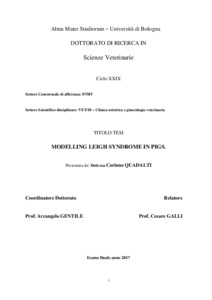Quadalti, Corinne
(2017)
Modelling Leigh Syndrome in pigs., [Dissertation thesis], Alma Mater Studiorum Università di Bologna.
Dottorato di ricerca in
Scienze veterinarie, 29 Ciclo. DOI 10.6092/unibo/amsdottorato/7912.
Documenti full-text disponibili:
![[img]](http://amsdottorato.unibo.it/7912/1.hassmallThumbnailVersion/Quadalti_Corinne_tesi.pdf)  Anteprima |
|
Documento PDF (English)
- Richiede un lettore di PDF come Xpdf o Adobe Acrobat Reader
Disponibile con Licenza: Salvo eventuali più ampie autorizzazioni dell'autore, la tesi può essere liberamente consultata e può essere effettuato il salvataggio e la stampa di una copia per fini strettamente personali di studio, di ricerca e di insegnamento, con espresso divieto di qualunque utilizzo direttamente o indirettamente commerciale. Ogni altro diritto sul materiale è riservato.
Download (7MB)
| Anteprima
|
Abstract
The generation of genetically modified animal models is a valuable tool to deepen scientific and medical knowledge of neurodegenerative diseases. Leigh syndrome associated with cytochrome C oxidase (COX) deficiency is an early onset, fatal mitochondrial encephalopathy characterized by neurodevelopmental regression and brain stem and basal ganglia lesions, frequently caused by mutations in the Surf1 gene, a nuclear gene that encodes a mitochondrial protein involved in COX assembly. The animal models of LS generated so far (Drosophila, Zebrafish, Mouse) fail to recapitulate simultaneously the human pathological and biochemical phenotype. In this thesis, we present the generation and the descriptive characterization of the first large animal model (swine) of Leigh Syndrome (LS), a well-characterized mitochondrial-derived ND. Since the complete and reliable sequence of swine Surf1 gene was not annotated in public databases, we sequenced the whole swine Surf1 gene to customize our genetic tools and precisely edit swine genome. To this purpose, we used the most recent genetic engineering technologies in terms of site-specific nucleases, as TALENs and CRISPR/Cas9, associated to a homologous recombination-based (HR) vector, to target swine Surf1 gene and generate an exon-specific double-strand break in order to knock out gene activity and thus reproduce null mutations reported in most human patients. Knockout (KO) and heterozygous animals were finally generated through Somatic Cell Nuclear Transfer (SCNT). A significant number of KO and heterozygous animals was generated and characterized, from both a clinical and a biochemical point of view. Surf1 KO animals exhibited an early lethal pathology onset, whereas heterozygous animals were completely comparable to wild type individuals. In conclusion, we successfully generated a Surf1 KO swine model, which needs to be further analysed as a promising tool to unveil the effective roles of Surf1 protein in metabolic pathways, in particular highlighting the perinatal period as a crucial moment.
Abstract
The generation of genetically modified animal models is a valuable tool to deepen scientific and medical knowledge of neurodegenerative diseases. Leigh syndrome associated with cytochrome C oxidase (COX) deficiency is an early onset, fatal mitochondrial encephalopathy characterized by neurodevelopmental regression and brain stem and basal ganglia lesions, frequently caused by mutations in the Surf1 gene, a nuclear gene that encodes a mitochondrial protein involved in COX assembly. The animal models of LS generated so far (Drosophila, Zebrafish, Mouse) fail to recapitulate simultaneously the human pathological and biochemical phenotype. In this thesis, we present the generation and the descriptive characterization of the first large animal model (swine) of Leigh Syndrome (LS), a well-characterized mitochondrial-derived ND. Since the complete and reliable sequence of swine Surf1 gene was not annotated in public databases, we sequenced the whole swine Surf1 gene to customize our genetic tools and precisely edit swine genome. To this purpose, we used the most recent genetic engineering technologies in terms of site-specific nucleases, as TALENs and CRISPR/Cas9, associated to a homologous recombination-based (HR) vector, to target swine Surf1 gene and generate an exon-specific double-strand break in order to knock out gene activity and thus reproduce null mutations reported in most human patients. Knockout (KO) and heterozygous animals were finally generated through Somatic Cell Nuclear Transfer (SCNT). A significant number of KO and heterozygous animals was generated and characterized, from both a clinical and a biochemical point of view. Surf1 KO animals exhibited an early lethal pathology onset, whereas heterozygous animals were completely comparable to wild type individuals. In conclusion, we successfully generated a Surf1 KO swine model, which needs to be further analysed as a promising tool to unveil the effective roles of Surf1 protein in metabolic pathways, in particular highlighting the perinatal period as a crucial moment.
Tipologia del documento
Tesi di dottorato
Autore
Quadalti, Corinne
Supervisore
Dottorato di ricerca
Ciclo
29
Coordinatore
Settore disciplinare
Settore concorsuale
Parole chiave
neurodegenerative disorder, mitochondrial disease, Leigh syndrome, swine animal model, COX
URN:NBN
DOI
10.6092/unibo/amsdottorato/7912
Data di discussione
21 Aprile 2017
URI
Altri metadati
Tipologia del documento
Tesi di dottorato
Autore
Quadalti, Corinne
Supervisore
Dottorato di ricerca
Ciclo
29
Coordinatore
Settore disciplinare
Settore concorsuale
Parole chiave
neurodegenerative disorder, mitochondrial disease, Leigh syndrome, swine animal model, COX
URN:NBN
DOI
10.6092/unibo/amsdottorato/7912
Data di discussione
21 Aprile 2017
URI
Statistica sui download
Gestione del documento:


 Login
Login
